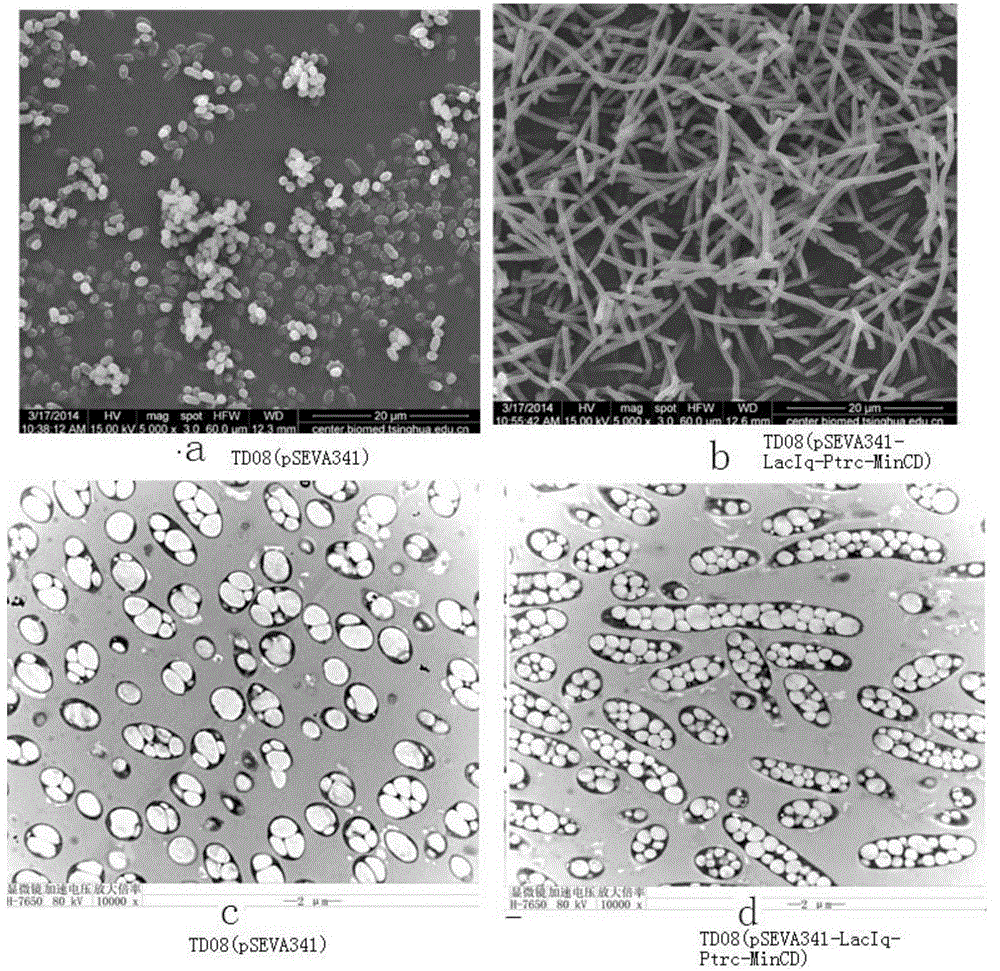Method for increasing microbe intracellular inclusion accumulation amount by increasing bacteria volume
A technology of microorganisms and inclusions, which is applied in the biological field and can solve problems such as obstacles to obtaining microbial inclusions
- Summary
- Abstract
- Description
- Claims
- Application Information
AI Technical Summary
Problems solved by technology
Method used
Image
Examples
Embodiment 1
[0077] Example 1. Enlarging cell volume and improving content production by changing mreB, sulA and minCD genes
[0078] 1. Construction of engineering bacteria
[0079] 1. Knock out the mreB gene of the starting bacteria to construct EscherichiacoliJM109SG△mreB
[0080]With mreB-KmTF and mreB-KmTR as primers, pKD13 plasmid (recorded in the following documents: DatsenkoK&WannerB (2000) One-stepinactivationofchromosomalgenesinEscherichiacoliK-12usingPCRproducts.ProceedingoftheNationalAcademyofScienceoftheUnitedStatesofAmerica97(12):64640-6 can be obtained from the public as a template from Tsinghua University The kanamycin resistance gene and FRT site were amplified by PCR reaction with pfu enzyme, and the mreB homology arm was introduced in two sections.
[0081] Primers are:
[0082] mreB-kmTF:
[0083] 5' ATGTTGAAAAAATTTCGTGGCATGTTTTTCCAATGACTTGTCCATTGACCTGGGTACT ATT
[0084] homology arm
[0085] CCGGGGATCCGTCGACC3'
[0086] mreB-KmTR:
[0087] 5' CGCCGCCGTGCATGT...
Embodiment 2
[0234] Embodiment 2, increasing the volume of Bacillus subtilis increases the content of PHB content
[0235] 1. Construction of recombinant Bacillus subtilis 168△SigD△lytE△lytD(pBHR68)
[0236] 1. Construction of 168△SigD
[0237] Using Bacillus subtilis 168 (AnagnostopoulosandJ.Spizizen.1961.RequirementfortransformationinBacillussubtilis.J.Bacteriol.81:741-746, available to the public from Tsinghua University) as a template, the following primer pairs were used for PCR amplification:
[0238] SigD-up-F: gcatgcctgcaggtcgactagctgaaagcgcatatgttta
[0239] SigD-up-R: AGCAGATTCTTTAATTTTCCCCCTAATACCTTAATTA
[0240] SigD-down-F: ggtattaggggaaaattaaagaatctgctggaaaaag
[0241] SigD-down-R: CGAATTCGAGCTCGGTACCCAACACAGCTTTATCCGACA
[0242] The 594bp SigD upstream homology arm (sequence 15 from the 5' end 20bp-613bp nucleotide), the 588bp SigD downstream homology arm (sequence 15 from the 5' end 614bp-1201bp nucleotide), In addition, the plasmid vector pCU was double digested with ...
Embodiment 3
[0273] Example 3, Production of Proteus Escherichia coli PHB with Knockout of Genes Related to Cell Wall Synthesis
[0274] The biological functions of some high-molecular-weight penicillin-binding proteins (PBPs) of bacteria have been elucidated, but the physiological functions of low-molecular-weight PBPs are still unclear. Morphological observation of Escherichia coli with mutations in some PBPs found that the diameter, profile and topological structure of PBP5 knockout Escherichia coli were changed. When the activity of PBP3 or FtsZ is inhibited, the bacteria will grow longer. PBP5 is an enzyme that removes the terminal D-alanine residue of the peptidoglycan pentapeptide side chain. Mutations in PBP5 are not lethal, possibly due to the presence of one or more other low-molecular-weight PBPs that can Fill the vacancy of PBP5.
[0275] Penicillin-binding proteins (PBPs) are a series of key proteins in the process of peptidoglycan synthesis. There are currently 12 discovere...
PUM
 Login to View More
Login to View More Abstract
Description
Claims
Application Information
 Login to View More
Login to View More - R&D
- Intellectual Property
- Life Sciences
- Materials
- Tech Scout
- Unparalleled Data Quality
- Higher Quality Content
- 60% Fewer Hallucinations
Browse by: Latest US Patents, China's latest patents, Technical Efficacy Thesaurus, Application Domain, Technology Topic, Popular Technical Reports.
© 2025 PatSnap. All rights reserved.Legal|Privacy policy|Modern Slavery Act Transparency Statement|Sitemap|About US| Contact US: help@patsnap.com



